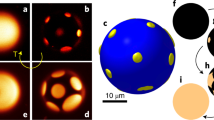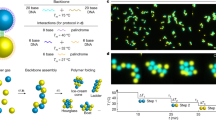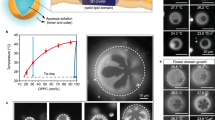Abstract
Revealing the chemical and physical mechanisms underlying symmetry breaking and shape transformations is key to understanding morphogenesis1. If we are to synthesize artificial structures with similar control and complexity to biological systems, we need energy- and material-efficient bottom-up processes to create building blocks of various shapes that can further assemble into hierarchical structures. Lithographic top-down processing2 allows a high level of structural control in microparticle production but at the expense of limited productivity. Conversely, bottom-up particle syntheses3,4,5,6,7,8 have higher material and energy efficiency, but are more limited in the shapes achievable. Linear hydrocarbons are known to pass through a series of metastable plastic rotator phases before freezing9,10. Here we show that by using appropriate cooling protocols, we can harness these phase transitions to control the deformation of liquid hydrocarbon droplets and then freeze them into solid particles, permanently preserving their shape. Upon cooling, the droplets spontaneously break their shape symmetry several times, morphing through a series of complex regular shapes owing to the internal phase-transition processes. In this way we produce particles including micrometre-sized octahedra, various polygonal platelets, O-shapes, and fibres of submicrometre diameter, which can be selectively frozen into the corresponding solid particles. This mechanism offers insights into achieving complex morphogenesis from a system with a minimal number of molecular components.
This is a preview of subscription content, access via your institution
Access options
Subscribe to this journal
Receive 51 print issues and online access
$199.00 per year
only $3.90 per issue
Buy this article
- Purchase on SpringerLink
- Instant access to full article PDF
Prices may be subject to local taxes which are calculated during checkout




Similar content being viewed by others
References
Turing, A. M. The chemical basis of morphogenesis. Philos. Trans. R. Soc. Lond. 237, 37–72 (1952)
Champion, J. A., Katare, Y. K. & Mitragotri, S. Particle shape: a new design parameter for micro- and nanoscale drug delivery carriers. J. Control. Release 121, 3–9 (2007)
Xiao, J. & Qi, L. Surfactant-assisted, shape-controlled synthesis of gold nanocrystals. Nanoscale 3, 1383–1396 (2011)
Peng, X. et al. Shape control of CdSe nanocrystals. Nature 2, 145–150 (2003)
Alargova, R. G., Bhatt, K. H., Paunov, V. N. & Velev, O. D. Scalable synthesis of a new class of polymer microrods by a liquid-liquid dispersion technique. Adv. Mater. 16, 1653–1657 (2004)
Dendukuri, D. & Doyle, P. S. The synthesis and assembly of polymeric microparticles using microfluidics. Adv. Mater. 21, 4071–4086 (2009)
Deitzel, J. M., Kleinmeyer, J., Harris, D. & Beck Tan, N. C. The effect of processing variables on the morphology of electrospun nanofibers and textiles. Polymer 42, 261–272 (2001)
Smoukov, S. K. et al. Scalable liquid shear-driven synthesis of polymer nanomaterials. Adv. Mater. 27, 2642–2647 (2015)
Sirota, E. B. & Herhold, A. B. Transient phase-induced nucleation. Science 283, 529–532 (1999)
Ueno, S., Hamada, Y. & Sato, K. Controlling polymorphic crystallization of n-alkane crystals in emulsion droplets through interfacial heterogeneous nucleation. Cryst. Growth Des. 3, 935–939 (2003)
Jeong, J., Davidson, Z. S., Collings, P. J., Lubensky, T. C. & Yodh, A. G. Chiral symmetry breaking and surface faceting in chromonic liquid crystal droplets with giant elastic anisotropy. Proc. Natl Acad. Sci. USA 111, 1742–1747 (2014)
Stone, H. Dynamics of drop deformation and breakup in viscous fluids. Annu. Rev. Fluid Mech. 26, 65–102 (1994)
Zhang, L.-Y., Zhang, Q.-K. & Zhang, Y.-D. Design, synthesis, and characterisation of symmetrical bent-core liquid crystalline dimers with diacetylene spacer. Liq. Cryst. 40, 1263–1273 (2013)
Wittebrood, M. M., Luijendijk, D. H., Stallinga, S., Rasing, Th. & Musevic, I. Thickness-dependent phase transition in thin nematic films. Phys. Rev. E Stat. Phys. Plasmas Fluids Relat. Interdiscip. Topics 54, 5232–5234 (1996)
Miyano, K. Surface-induced ordering of a liquid crystal in the isotropic phase. J. Chem. Phys. 71, 4108–4111 (1979)
Bloss, F. D. An Introduction to the Methods of Optical Crystallography (Holt, Rinehart and Winston, 1961)
Israelachvili, J. N. Intermolecular and Surface Forces (Academic, 2011)
Evans, E. A. & Skalak, R. Mechanics and Thermodynamics of Biomembranes (CRC, 1980)
Jung, H. T., Coldren, B., Zasadzinski, J. A., Iampietro, D. J. & Kaler, E. W. The origins of stability of spontaneous vesicles. Proc. Natl Acad. Sci. USA 98, 1353–1357 (2001)
Peddireddy, K. et al. Lasing and waveguiding in smectic A liquid crystal optical fibers. Opt. Express 21, 30233–30242 (2013)
Peddireddy, K., Kumar, P., Thutupalli, S., Herminghaus, S. & Bahr, C. Myelin structures formed by thermotropic smectic liquid crystals. Langmuir 29, 15682–15688 (2013)
Gratton, S. E. et al. The effect of particle design on cellular internalization pathways. Proc. Natl Acad. Sci. USA 105, 11613–11618 (2008)
Decuzzi, P. et al. Size and shape effects in the biodistribution of intravascularly injected particles. J. Control. Release 141, 320–327 (2010)
Makgwane, P. R. & Ray, S. S. Synthesis of nanomaterials by continuous-flow microfluidics: a review. J. Nanosci. Nanotechnol. 14, 1338–1363 (2014)
Kim, J.-W., Utada, A. S., Fernández-Nieves, A., Hu, Z. & Weitz, D. A. Fabrication of monodisperse gel shells and functional microgels in microfluidic devices. Angew. Chem. Int. Ed. 46, 1819–1822 (2007)
Neville, A. C. Molecular and mechanical aspects of helicoid development in plant cell walls. BioEssays 3, 4–8 (1985)
Li, Y., Miao, H., Ma, H. & Chen, J. Z. Y. Topological defects of tetratic liquid-crystal order on a soft spherical surface. Soft Matter 9, 11461–11466 (2013)
Bowick, M. J. & Giomi, L. Two-dimensional matter: order, curvature and defects. Adv. Phys. 58, 449–563 (2009)
Acknowledgements
This work was funded by the European Research Council (ERC) grant to S.K.S., EMATTER (#280078). The study falls under the umbrella of European networks COST MP 1106 and 1305 and the capacity building project BeyondEverest of the European Commission (grant no. 286205).
Author information
Authors and Affiliations
Contributions
N.D. and S.T. conceived the main idea for the study, designed the experiments and performed most of the result interpretation, N.D. wrote the first draft, I.L. and D.C. performed the experiments and prepared the figures, S.K.S. contributed important ideas for the experiments and data and mechanism interpretation, and edited the text.
Corresponding author
Ethics declarations
Competing interests
The authors declare no competing financial interests.
Extended data figures and tables
Extended Data Figure 1 Solid particles with various shapes.
a–h, The shapes were obtained by freezing of deformed hexadecane (a–d), heptadecane (e), tetradecane (f), or eicosane (g, h) drops in emulsions, stabilized by 1.5 wt% of different surfactants: a, non-ionic Tween 60; b, c, non-ionic Brij 78; d, cationic CTAB; e, f, non-ionic Tween 40; g, h, Brij 78. Scale bars, 20 μm.
Extended Data Figure 2 Snapshot images of multiple hexadecane particles, obtained in 1.5 wt% solutions of various surfactants.
a–h, Tween 60 (a–e), Brij 58 (f) and Tween 40 (g, h). a–d, Consecutive images from the evolution of emulsion droplets stabilized by Tween 60. e, Rod-like particles before freezing. f, Frozen triangular particles. g, Frozen tetragonal platelets. h, Frozen toroidal particles. The initial drop sizes of the particles are indicated on the pictures. Cooling rates are 0.5 K min−1, except for h, 2 K min−1.
Extended Data Figure 3 Images proving that the deformed drops are still fluid.
Extending drops collide with each other and bend, as shown with the black arrow. Images of hexadecane drops in 1.5 wt% aqueous solution of Brij 58, cooled with rate of 1 K min−1.
Extended Data Figure 4 Experimental setup.
a, Schematic presentation of the cooling chamber with optical windows, used for microscope observation of the emulsion samples. b, The studied emulsions are contained in glass capillaries, placed in the thermostatic chamber and observed through the optical windows.
Supplementary information
Supplementary Information
This file contains Supplementary Text and Data and an additional reference. (PDF 150 kb)
Video with the shape transformations of hexadecane-in-water drops
Video with the shape transformations of hexadecane-in-water drops, stabilized by the nonionic surfactant Brij 58 and cooled with rate of 0.4 K/min. This video illustrates the drop-shape evolution shown in Figures 1 and 2. (AVI 4952 kb)
Video with the shape transformation of hexadecane-in-water drops
Video with the shape transformation of hexadecane-in-water drops, stabilized by the nonionic surfactant Tween 60 and cooled with rate of 0.4 K/min. This video demonstrates the formation of doughnut-shaped drops which could exist only if the drops contain liquid-crystalline material with certain elastic properties. (AVI 3637 kb)
Rights and permissions
About this article
Cite this article
Denkov, N., Tcholakova, S., Lesov, I. et al. Self-shaping of oil droplets via the formation of intermediate rotator phases upon cooling. Nature 528, 392–395 (2015). https://doi.org/10.1038/nature16189
Received:
Accepted:
Published:
Issue Date:
DOI: https://doi.org/10.1038/nature16189



